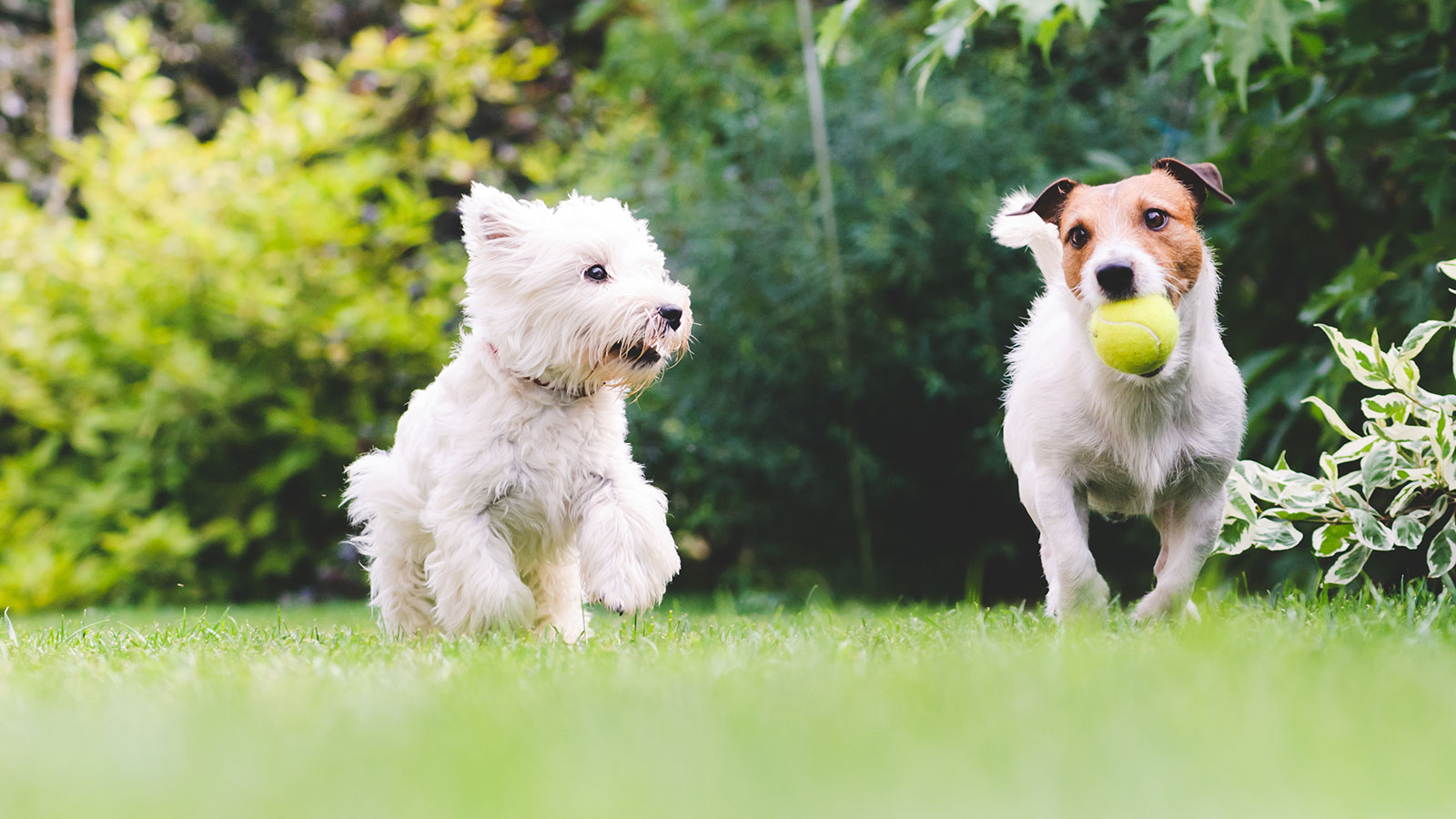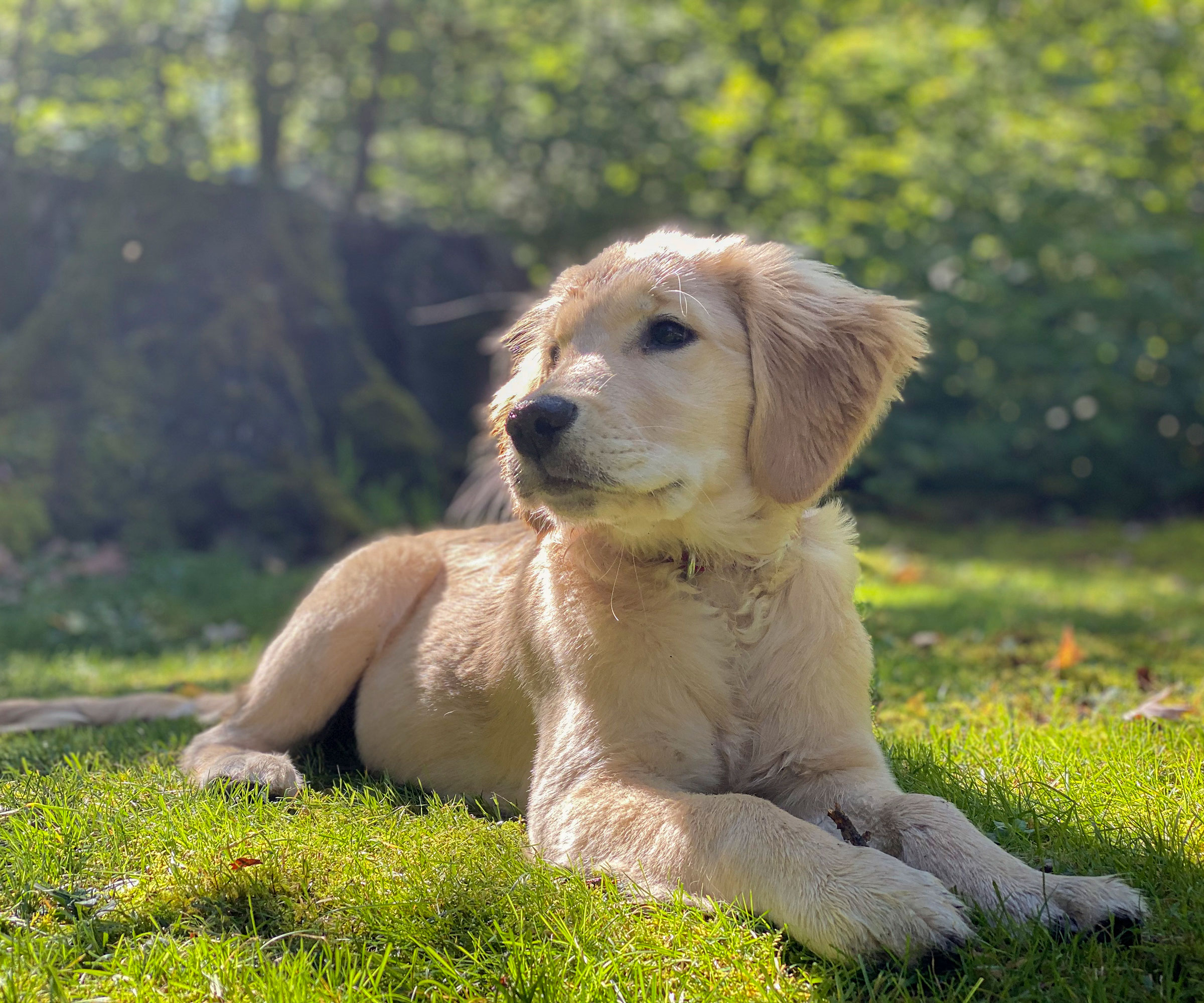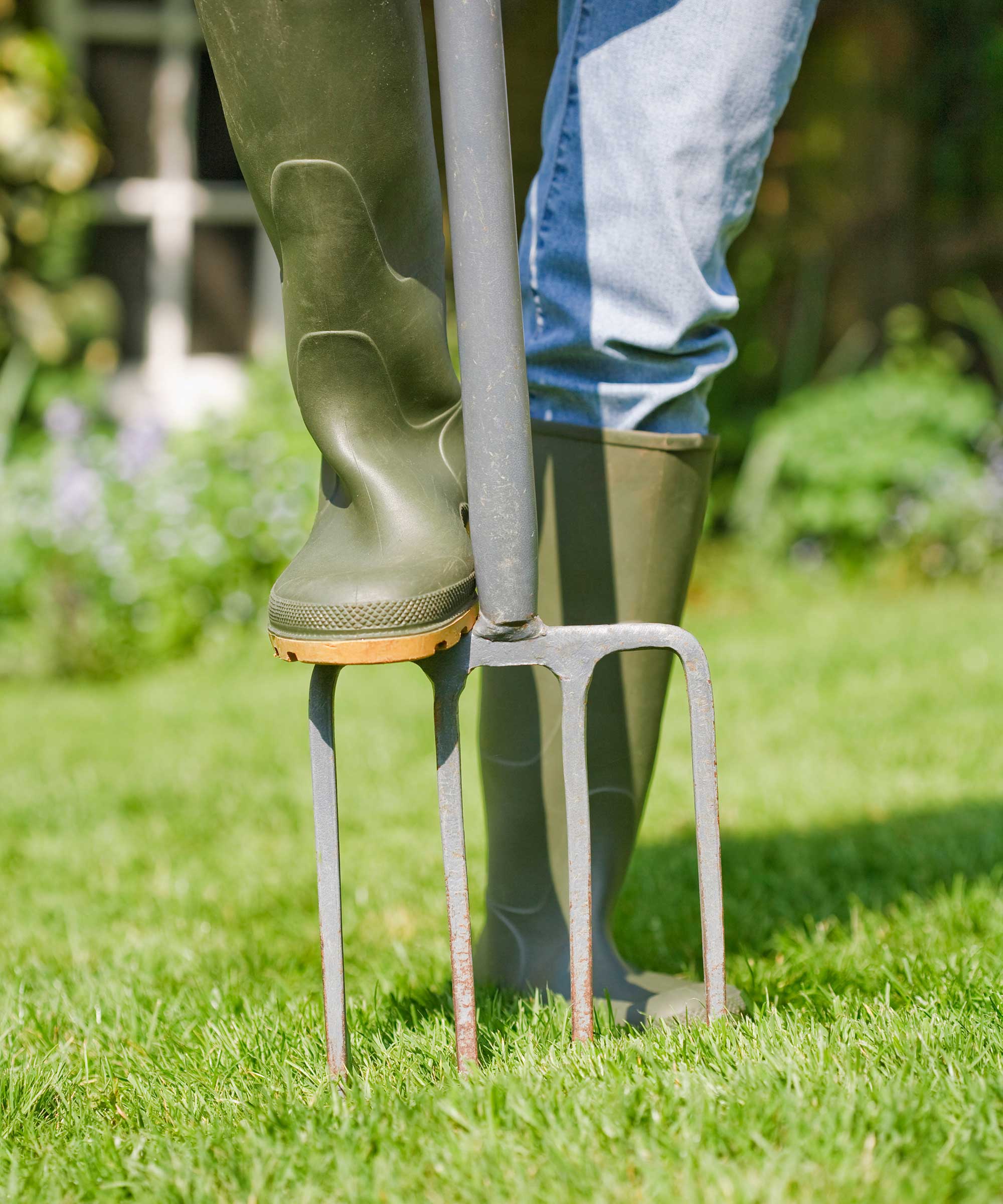How to grow grass with dogs – 7 ways to protect your lawn from pet damage
Learn how your lawn and pooch can live in harmony outdoors


If your lawn is suffering at the paws of your canine pal, then stop despairing and follow our simple guide on how to grow grass with dogs instead. Full of game-changing tips from landscape designers, lawn care and pet experts, you can begin rectifying any damage and start enjoying your grass again.
There’s no doubt that watching the family dog freely paw, dig and play on the lawn can result in mixed emotions. Sure, they are a much-loved and adored part of the household just following their natural instincts, but we all know how much damage they can reap, and how much lawn care effort it takes to restore the grass back to its green and lush best.
Luckily, help is at hand. We’ve called on our panel of pet and horticultural experts for their top tips. Equipped with hard-earned knowledge gathered through years of experience, they can give you the realistic lowdown on how to cultivate a dog-friendly lawn.
7 smart ways to grow grass with dogs
Looking for dog-friendly lawn tips? Then follow our handy guide on how you can grow a beautiful lawn that won't get ruined by your pets.
1. Choose dog-friendly grass varieties
There are plenty of factors to consider when planting grass seed or establishing a lawn, and deciding on the most suitable grass variety tops the list. Selection should be based on climate, soil type, sun exposure and wear, but if you also have a family dog do acknowledge their needs too.
‘When it comes to choosing a dog-friendly grass type, the most important factor to consider is durability,' says Dr Gabrielle Fadl, Director of Primary Care at Bond Vet. 'You'll want a grass variety that can withstand the wear and tear of regular foot traffic, including dogs running and playing. Some of the best grass types for dogs include Bermuda grass, zoysia grass, and Kentucky Bluegrass. These grasses are known for their resilience and are less likely to be damaged by dog urine.’
Ryan Farley, CEO of Lawn Starter agrees: ‘Bermuda grass and zoysia grass are great for yards with dogs because of their durability and resilience. They can recover quickly from damage caused by dogs and other pets, and they also tolerate heat and drought conditions better than most other types of grass.’
Design expertise in your inbox – from inspiring decorating ideas and beautiful celebrity homes to practical gardening advice and shopping round-ups.
Scotts Turf Builder Bermuda grass seed from Amazon is drought resistant and can tolerate heat, while Scotts Turf Builder Kentucky Bluegrass Mix from Amazon is designed to create a tough, durable lawn and has medium drought resistance.
2. Avoid allergenic grass types
Keeping our pooches happy and healthy is of prime importance, and choosing which type of grass to grow in the lawn can actually play a big role in creating a dog-friendly backyard.
‘There are some grass varieties that you may want to avoid if you have a dog at home,’ continues Dr Gabrielle. ‘Some dogs may be allergic to certain types of grass, so it's important to monitor your dog for any signs of skin irritation or respiratory distress.’
Some fescues and rye grass can be an irritant for some dogs and symptoms such as red itchy skin or feet, sneezing or runny eyes or nose are caused either by direct contact with grass or from inhaling the pollen. This is most likely to be an issue during spring and fall.
Mild cases can often be soothed by over-the-counter shampoos, mild oatmeal-based pet shampoo or medicated paw wipes, but if concerned always seek professional veterinarian advice. The same advice applies if you think your pet may have eaten a plant that is poisonous to dogs – always seek advice from a vet on the best course of action.

3. Adapt your yard’s landscaping
A degree of compromise is needed when letting your dog enjoy the garden, and this can mean rethinking your backyard landscaping and layout. If your pooch persistently destroys one area of lawn it may be time for a redesign.
Gene Caballero, co-founder of lawn specialists Green Pal explains, ‘To prevent doggy-digging patches in your lawn, you can use some smart landscaping tricks. One of the easiest ways is to install raised garden beds or planters in the areas where your dog loves to dig.’
With construction methods ranging from ready-made Corten steel containers, stacked railroad sleepers to chic blockwork and rendered raised borders, you can really adapt the look and size to suit your plot.
4. Hose down dog pee
Dogs love to pee on grass and often have their preferred go-to spots, which can be a real nightmare for lawn lovers. Although not a simple or quick issue to solve, lawn care expert Eric DeBoer, an agronomist at Simple Lawn Solutions has a couple of suggestions. ‘For urine damage, the biggest thing you can do is dilute the urine as quickly as possible after they use the bathroom,’ says. ‘There are products on the market for repairing pet patches, but there really is no silver bullet for avoiding or curing this malady. Once the urine damage has turned the grass yellow, there is no miracle cure that will bring the grass back to life in a couple of days. It takes time to fill in from the edges.’
Using grass ‘plugs’ is a speedy solution for repairing patches in grass, as Eric explains. ‘What you can do, if you have grass that spreads from stolons or rhizomes (Kentucky bluegrass, creeping fescues, warm-season grasses) is take a plug of grass from a good area of the lawn and place it in the center of the damaged area. Then fill the original hole with topsoil, sand, or compost. This will give you two smaller "damaged" areas that will fill in faster than one large dead spot.’
5. Aerate the lawn for a rapid recovery
Keeping your lawn in a healthy condition will help it bounce back from any damage, so take another tip from Eric and learn how to aerate your lawn. ‘For traffic damage, nitrogen, water, and sun will help the lawn recover. Getting after any compacted areas with a core aerifier can help relieve some compaction and allow water and nutrients deeper into the soil profile.’
When it comes to managing dreams of permanently lush swards Eric does encourage a degree of reality though. ‘Remember that all grasses have their limits. Turf managers have trouble keeping grass growing in front of goal mouths and frequently trafficked areas, and this would be no different. If your dog has a spot where they just love to run back and forth, maybe opt for mulch or crumb rubber in that area to keep it from becoming a complete mud pit.’

Aerating a lawn with a garden fork can help to break up compacted areas of turf
6. Nurture grass with dog-friendly fertilizers
‘Dog-friendly fertilizers can be a game changer if you're looking to grow your grass without your furry friend destroying it,’ says Ryan Farley. ‘Many fertilizers contain chemicals that can be harmful to dogs if ingested. To keep your dog safe and healthy while also keeping your grass growing, consider using dog-friendly fertilizers that are made with natural ingredients. These are safe for pets to play and walk on and they also promote healthy grass growth. This way, you can grow your lawn green and thick without worrying about your pup getting sick.’
7. Fill in bare patches promptly
Bare patches in a lawn not only look unsightly but can encourage your dog – and other pets and wildlife – to keep adding to the result.
An easy win for getting paws into the soil below – whether to use as a toilet or as a burying patch – it makes sense to repair the area ASAP.
‘For repairing doggy digging patches, you can use a mixture of soil and fast-growing grass seed to fill in the hole,’ advises Gene Cabellero. ‘It's important to keep the soil moist and avoid stepping on the newly planted grass until it's well-established.’

Keep on top of any damaged areas and repair them quickly to discourage dogs from digging
8. Designate a doggy area
If yard space allows, separating off a spot just for your pup can alleviate stress all round. Away from the lawn and those pristinely clipped lawn edges, this simple compromise can prove a real game changer.
Take a fresh look at your yard for potential locations. Often an underused area to the side of the house or at the end of the plot can be turned into a safe and stimulating play space.
‘As far as separating an area in your yard goes, it's hard to top an old-fashioned garden fence,' says Eric De Boer. 'Depending on the size of your dog, you could box areas off using tall planter boxes which you can use for growing flowers and vegetables, as well as a barrier. A living fence of willow, hazel or bamboo can work well for smaller dogs, but if you do plant bamboo, be prepared for it to be a part of your family for as long as you're in living in that house.’
To keep your pets safe and secure in your yard, make sure you also consider dog proofing your existing fencing and any other boundaries you may have.
FAQs
How can I stop my dog peeing on the grass?
Training your dog to use a designated bathroom spot is a great way to keep your lawn pristine. Of course, this very much depends on your pet’s personality and needs, but persistence can pay off. Gene Cabellero, co-founder of Green Pal says, ‘This can be achieved by consistently guiding your dog to a designated grassy area every time they need to go to the toilet and rewarding them with treats. Over time, they will learn to associate that area with their bathroom needs.’
Dog-friendly repellents are another option worth trying. Ranging from commercial granular repellents to natural and household resources such as vinegar, citrus peel, cinnamon and thyme oil, they can be scattered around the perimeter of a particular area to keep pets at bay.
There's no doubt that successfully growing grass with dogs will involve extra work, but when combined with some careful dog training it can be possible. 'It's really important to discourage unwanted behavior,' says Dr Gabrielle Fadl. 'If you catch your dog digging or peeing on the grass, use a firm "no" command to stop them. Then, redirect them to the designated potty area and reward them when they go in the right spot.'
'Some dogs also dig out of boredom or excess energy,' adds Gabrielle. 'Provide plenty of opportunities for exercise and play and provide chew toys or puzzle toys to keep them mentally stimulated.'

Journalist Jill Morgan has spent over 20 years writing and editing gardening, interior and property features. Titles she has worked on include The English Home, House Beautiful, Ideal Home, Houzz and Modern Gardens and she writes regularly for H&G as a Contributing Editor. Whilst she is a dab hand at renovation projects and DIY, she is happiest when out digging in the garden or planning a new border.